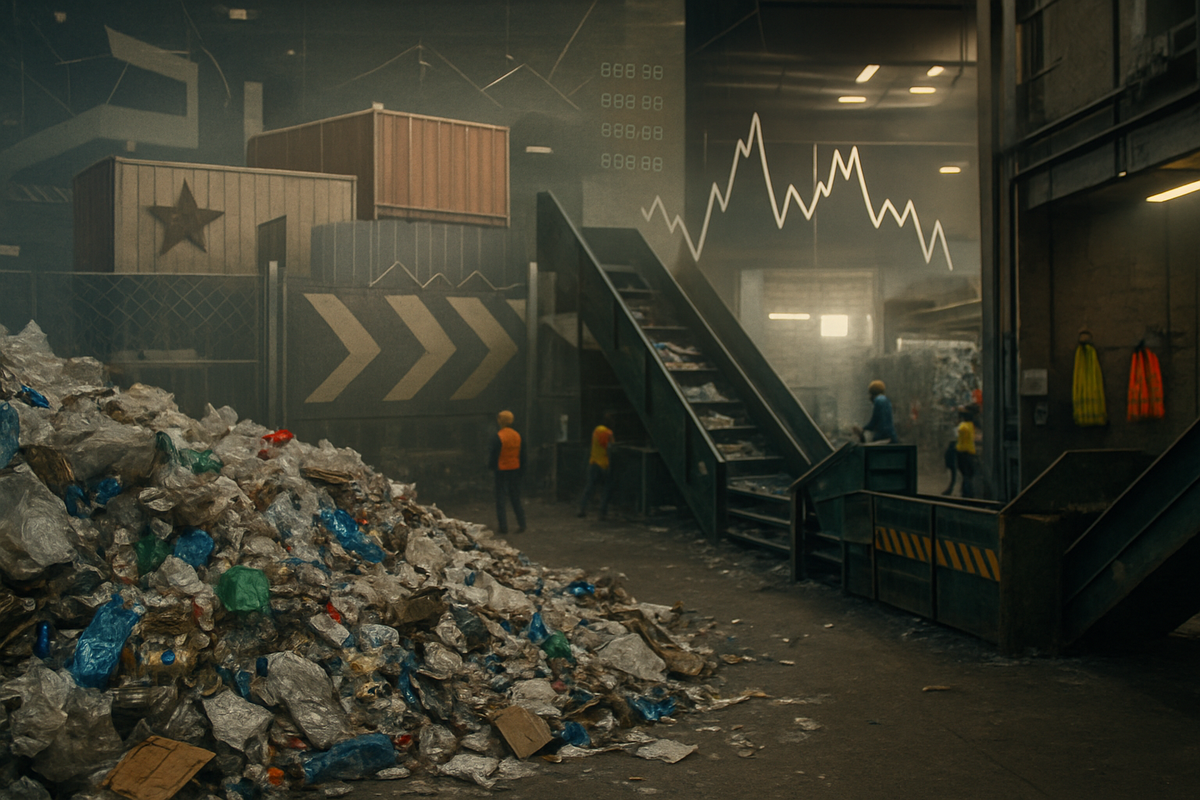
The global recycling industry is currently navigating a turbulent economic landscape, facing a formidable triple threat from escalating tariffs, persistent labor shortages, and unpredictable commodity market volatility. As of October 2025, these intertwined challenges are significantly impacting operational costs, disrupting supply chains, and reshaping the profitability of an industry critical to global sustainability efforts. Recyclers are finding themselves at a critical juncture, forced to innovate and adapt amidst a period of heightened uncertainty that threatens to undermine progress toward a circular economy.
The immediate implications are far-reaching, affecting everything from the cost of processing materials to the viability of recycling certain waste streams. Higher operational expenses, driven by increased labor costs and tariffs on essential equipment, are squeezing profit margins, while fluctuating prices for recycled plastics, metals, and paper make long-term planning a precarious endeavor. This confluence of headwinds creates a challenging environment for both established waste management giants and smaller, specialized recycling operations, pushing many to reconsider strategies and invest in new technologies to stay afloat.
The Unfolding Crisis: A Deep Dive into Industry Headwinds
The current predicament for the recycling sector is a culmination of several powerful economic and political forces that have intensified over the past few years, reaching a critical point in 2025.
Tariffs: A Barrier to Global Trade Tariffs, particularly those imposed by the U.S. on imports from key trading partners such as Canada, Mexico, and China, are creating significant disruptions. These duties affect not only finished goods but also critical recycling equipment like sorting machines and shredders, driving up capital expenditures for facilities. More critically, they impact the trade of recycled materials themselves. For instance, proposed tariffs on containerboard from Canada and Mexico, which account for a substantial portion of U.S. imports, threaten to destabilize the fiber market, potentially reversing recent price stabilizations for recycled cardboard (OCC). In plastics, tariffs on PET resin from Mexico could elevate prices, making recycled plastic less competitive against cheaper virgin alternatives. The Section 232 tariffs on aluminum and steel, which saw increases to 50% in 2025, while intended to bolster domestic production, have led to retaliatory tariffs from other nations, jeopardizing the U.S.'s substantial scrap metal export market, with 40% of its scrap typically going to countries like Turkey, India, and China. This uncertainty can lead to domestic oversupply and depressed prices, ultimately increasing landfilling if cost-effective export or processing options diminish.
Persistent Labor Shortages: Straining Operations The recycling industry, much like many other sectors, continues to grapple with severe labor shortages. The scarcity of qualified personnel, particularly CDL drivers essential for material transport and frontline sorting line operators, is a major operational bottleneck. Companies are compelled to offer higher wages to attract and retain staff, directly increasing operating costs. For example, some firms have reported significant quarterly cost increases, sometimes upwards of $700,000, due to rising labor expenses. This shortage not only impacts daily operations and efficiency but also limits the industry's capacity for growth, as companies struggle to take on new business without adequate staffing. The reliance on manual sorting in many facilities means that a robust workforce is crucial, and the current deficit is pushing companies towards greater automation and AI-driven sorting systems as a long-term solution to mitigate labor dependency.
Volatile Commodity Markets: An Economic Rollercoaster The unpredictable swings in prices for recycled commodities are a constant source of anxiety and financial instability for the recycling industry. Prices for materials such as copper, graphite, rare earth elements, critical metals (e.g., lithium and cobalt from e-waste), precious metals, aluminum, various grades of paper (OCC, mixed paper), and plastics (PET, HDPE) are subject to rapid and often dramatic fluctuations. This volatility can quickly erode profit margins, making financial forecasting and risk management incredibly challenging. Economic headwinds in early 2025 saw companies like Waste Management (NYSE: WM) project a blended recycled commodity price of around $85 per ton, a decrease from the previous year, while Republic Services (NYSE: RSG) anticipated a drop from $164 per ton to $145 per ton. These declines are influenced by global supply and demand dynamics, geopolitical tensions, shifts in consumer behavior, and a general economic slowdown. While some plastic grades have shown resilience, softness in the fiber market has often offset gains in other materials, creating an uneven performance across the sector.
Winners and Losers: Corporate Resilience in a Shifting Market
The current market conditions are creating a clear divide between companies that are well-positioned to weather the storm and those facing significant headwinds.
Companies Facing Challenges: Smaller, regionally focused recycling operations and those heavily reliant on export markets for specific materials are particularly vulnerable. Without the scale or capital to invest in advanced automation or diversify their revenue streams, these entities struggle to absorb increased operational costs from tariffs and labor, or to mitigate the risks of volatile commodity prices. Companies with limited domestic processing capabilities for materials like mixed plastics or lower-grade paper might find themselves with stockpiles and reduced profitability due to export market closures or high tariff barriers. Firms that have not invested in modernizing their material recovery facilities (MRFs) will continue to bear the brunt of labor shortages, as manual sorting becomes increasingly expensive and inefficient.
Companies Showing Resilience or Potential to Win: Larger, integrated waste management companies with diversified services and significant capital, such as Waste Management (NYSE: WM) and Republic Services (NYSE: RSG), are better equipped to navigate these challenges. Their scale allows for greater investment in automation, which can offset labor shortages, and their diversified revenue streams from collection, landfill, and energy-from-waste operations provide a buffer against commodity price swings. These companies are actively investing in advanced sorting technologies and internal training programs to enhance efficiency and worker retention. Furthermore, manufacturers and brands that have made significant commitments to using recycled content, such as many consumer packaged goods (CPG) companies, may increasingly seek out stable, long-term supply agreements with reliable domestic recyclers. This push for circular supply chains, particularly for materials like PET where bottles are recycled back into bottles, can create more stable demand and pricing for high-quality recycled content, benefiting recyclers able to produce it. Companies focused on high-value materials, such as critical metals from e-waste, where demand remains strong and processing technologies are evolving, also present a potential growth area.
Wider Significance: Reshaping the Circular Economy
The challenges currently facing the recycling sector are not isolated incidents but rather significant tremors within the broader landscape of global sustainability and economic development.
Broader Industry Trends and Ripple Effects: These headwinds threaten to slow progress toward a truly circular economy, where materials are kept in use for as long as possible. If recycling becomes economically unviable, more materials will inevitably be diverted to landfills or incineration, counteracting global efforts to reduce waste and carbon emissions. Manufacturers relying on recycled content, from packaging producers to automotive companies, could face higher input costs or struggle to meet their sustainability targets if the supply of quality recycled materials dwindles or becomes too expensive. This could lead to a ripple effect, potentially increasing the use of virgin materials and impacting the environmental footprint of numerous industries. Waste generators, including municipalities and businesses, might see increased costs for waste disposal if recycling options contract.
Regulatory and Policy Implications: The current environment underscores the urgent need for robust regulatory frameworks and supportive policies. Extended Producer Responsibility (EPR) schemes, which hold producers accountable for the end-of-life management of their products, are gaining traction globally and are expected to significantly shape the industry in 2025 and beyond. These policies, alongside higher recycled content mandates, could create a more stable demand for recycled materials, but they also introduce compliance complexities, especially for international trade. Governments may need to consider subsidies or incentives for domestic recycling infrastructure, or re-evaluate tariff policies to ensure they do not inadvertently harm the recycling sector and broader environmental goals. The ongoing policy debates around waste shipment regulations and green industrial policies will be critical in determining the sector's trajectory.
Historical Precedents and Comparisons: While the specific combination of tariffs, labor issues, and commodity volatility is unique to this period, the recycling industry has faced cyclical challenges before. Past disruptions, such as China's "National Sword" policy in 2018, which severely restricted imports of certain recycled materials, led to a similar crisis of oversupply and depressed prices, forcing many countries to rapidly invest in domestic processing capabilities. The current situation echoes those times, highlighting the fragility of global recycling networks and the critical importance of diversified markets and resilient domestic infrastructure.
What Comes Next: Navigating the Future of Recycling
The path forward for the recycling industry will require strategic adaptation, technological innovation, and potentially significant policy shifts.
Short-term and Long-term Possibilities: In the short term, companies will continue to focus on operational efficiencies, including route optimization and "back-to-back" sales strategies to minimize exposure to commodity price swings. The immediate future will likely see continued investment in automation and AI-driven sorting to mitigate labor costs and improve material quality. Long-term, the industry is poised for significant transformation driven by advanced technologies like chemical recycling for difficult plastics (e.g., pyrolysis, depolymerization) and enhanced processing for e-waste to recover critical metals. These innovations could unlock new revenue streams and increase the range of materials that can be economically recycled.
Strategic Pivots and Adaptations: Recycling companies may pivot towards greater vertical integration, controlling more of the supply chain from collection to processing and even manufacturing of recycled-content products. Diversification of services, moving beyond traditional material recovery to encompass broader waste-to-energy solutions or specialized material reprocessing, could also become more common. Collaboration across the value chain, from material producers to brand owners, will be crucial to establish stable demand for recycled content and to design products that are inherently more recyclable.
Market Opportunities and Challenges: Despite the headwinds, opportunities exist. The growing consumer and corporate demand for sustainable products, coupled with stringent environmental regulations, will continue to drive the need for recycled content. This could foster new markets for high-quality recycled materials and attract investment into innovative recycling technologies. However, challenges such as the high capital cost of new technologies, the need for consistent feedstock quality, and ongoing competition from virgin materials will persist. Market consolidation may occur, with smaller players being acquired by larger entities seeking to expand their capabilities or market share.
Potential Scenarios and Outcomes: One scenario sees a bifurcation of the industry: highly automated, large-scale facilities processing high-demand materials efficiently, alongside specialized recyclers focusing on niche, high-value waste streams. Another scenario involves increased government intervention through subsidies or mandates to stabilize the market and support sustainability goals. The most optimistic outcome would be a robust, globally integrated, yet regionally resilient recycling infrastructure, where technological advancements and supportive policies overcome current challenges, leading to a truly circular economy.
Comprehensive Wrap-up: A Crossroads for a Vital Industry
The recycling sector stands at a critical crossroads in October 2025, grappling with a complex interplay of tariffs, labor shortages, and volatile commodity markets. These challenges are not merely operational hurdles; they represent a fundamental test of the industry's resilience and its ability to deliver on global sustainability promises.
Summary of Key Takeaways: The core takeaways are that tariffs are disrupting global trade flows and increasing costs, labor shortages are driving up operational expenses and pushing for automation, and commodity price volatility is making profitability unpredictable. While these factors create a difficult operating environment, they are also catalyzing innovation and driving a push towards more resilient, localized, and technologically advanced recycling infrastructure.
Assessment of the Market Moving Forward: The market moving forward will likely be characterized by increased consolidation, greater investment in automation and advanced recycling technologies, and a stronger emphasis on circular supply chains driven by regulatory mandates like EPR. Companies that can adapt quickly, diversify their operations, and leverage technology to improve efficiency and material quality will be best positioned for success.
Final Thoughts on Significance and Lasting Impact: The lasting impact of this period will be a more mature, albeit more complex, recycling industry. It will force a re-evaluation of global waste management strategies, emphasizing domestic processing capabilities and the development of robust, closed-loop systems. The importance of recycling for resource conservation, emission reduction, and job creation remains undeniable, and successfully navigating these challenges is crucial for a sustainable future.
What Investors Should Watch For: Investors should closely monitor companies' capital expenditure on automation and advanced recycling technologies, their ability to secure long-term contracts for recycled content, and their exposure to international trade policies. Watch for shifts in regulatory environments, particularly the implementation and effectiveness of EPR schemes and recycled content mandates. Furthermore, track commodity price trends, especially for key materials like plastics, aluminum, and paper, and observe how companies mitigate this volatility through diversification or hedging strategies.
This content is intended for informational purposes only and is not financial advice







